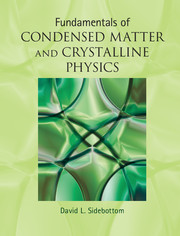 Fundamentals of Condensed Matter and Crystalline Physics
Fundamentals of Condensed Matter and Crystalline Physics Published online by Cambridge University Press: 05 August 2012
TRANSITIONS
On my bulletin board I have a picture of a recent U.S. president that someone has photo shopped to include a text balloon that says, “The ice caps are not melting. The water is being liberated.” Although intended to be humorous, there is an element of truth to this statement. Phase transitions are in many respects the result of a competition or war between two opposing forces. On one side are the attractive interactions between particles that act to bind them together and force them into a more ordered structure – a world governed by potential energy. On the other side is thermal energy that acts to break these bonds and liberate the particles so that they are free to move about – a world dominated by kinetic energy. There is then a point of transition where one world order trumps the other and it is this phenomenon that we consider in this final set of chapters.
There are many sorts of phase transitions, but the two prominent examples we will consider are the gas-to-liquid transition and the transition of paramagnet-to-ferromagnet. In spite of the obvious differences between these two systems, we will emphasize a remarkable level of similarity in how their phase transitions proceed and how order develops in both situations.
Beginning in Chapter 15, we lay some groundwork regarding the fundamental nature of phase transitions and explore the meanings behind various phase diagrams used to describe the transitions between different phases. Here we examine the competition between inter-particle interactions and thermodynamic forces in determining the conditions for phase transitions to occur and emphasize the special role played by thermodynamic fluctuations near socalled “critical” points, where certain thermodynamic quantities tend to diverge.
To save this book to your Kindle, first ensure [email protected] is added to your Approved Personal Document E-mail List under your Personal Document Settings on the Manage Your Content and Devices page of your Amazon account. Then enter the ‘name’ part of your Kindle email address below. Find out more about saving to your Kindle.
Note you can select to save to either the @free.kindle.com or @kindle.com variations. ‘@free.kindle.com’ emails are free but can only be saved to your device when it is connected to wi-fi. ‘@kindle.com’ emails can be delivered even when you are not connected to wi-fi, but note that service fees apply.
Find out more about the Kindle Personal Document Service.
To save content items to your account, please confirm that you agree to abide by our usage policies. If this is the first time you use this feature, you will be asked to authorise Cambridge Core to connect with your account. Find out more about saving content to Dropbox.
To save content items to your account, please confirm that you agree to abide by our usage policies. If this is the first time you use this feature, you will be asked to authorise Cambridge Core to connect with your account. Find out more about saving content to Google Drive.